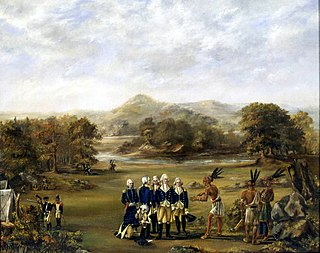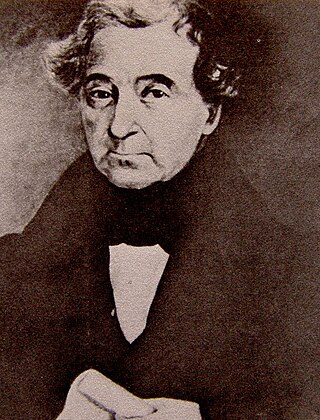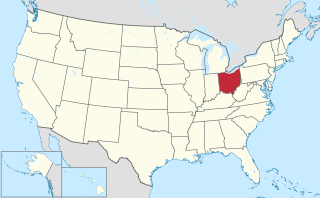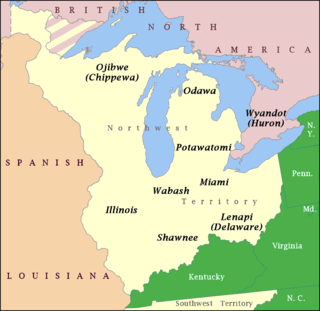Related Research Articles

Little Turtle was a Sagamore (chief) of the Miami people, who became one of the most famous Native American military leaders. Historian Wiley Sword calls him "perhaps the most capable Indian leader then in the Northwest Territory," although he later signed several treaties ceding land, which caused him to lose his leader status during the battles which became a prelude to the War of 1812. In the 1790s, Mihšihkinaahkwa led a confederation of native warriors to several major victories against U.S. forces in the Northwest Indian Wars, sometimes called "Little Turtle's War", particularly St. Clair's defeat in 1791, wherein the confederation defeated General Arthur St. Clair, who lost 900 men in the most decisive loss by the U.S. Army against Native American forces.

The Miami are a Native American nation originally speaking one of the Algonquian languages. Among the peoples known as the Great Lakes tribes, they occupied territory that is now identified as north-central Indiana, southwest Michigan, and western Ohio. The Miami were historically made up of several prominent subgroups, including the Piankeshaw, Wea, Pepikokia, Kilatika, Mengakonkia, and Atchakangouen. In modern times, Miami is used more specifically to refer to the Atchakangouen. By 1846, most of the Miami had been forcefully displaced to Indian Territory. The Miami Tribe of Oklahoma are the federally recognized tribe of Miami Indians in the United States. The Miami Nation of Indiana, a nonprofit organization of self-identified descendants of Miamis who were exempted from removal, have unsuccessfully sought separate recognition.

The Fort Wayne Old City Hall Building in downtown Fort Wayne, Indiana operates as a museum known as The History Center, and has served as headquarters for the Allen County–Fort Wayne Historical Society since 1980. The Richardsonian Romanesque style sandstone building was designed by the architectural firm Wing & Mahurin and built in 1893. It served as a functioning city hall for the city until 1971 when local officials moved to the City-County Building.

The Northwest Indian War (1785–1795), also known by other names, was an armed conflict for control of the Northwest Territory fought between the United States and a united group of Native American nations known today as the Northwestern Confederacy. The United States Army considers it the first of the American Indian Wars.
Kekionga, also known as Kiskakon or Pacan's Village, was the capital of the Miami tribe. It was located at the confluence of the Saint Joseph and Saint Marys rivers to form the Maumee River on the western edge of the Great Black Swamp in present-day Indiana. Over their respective decades of influence from colonial times to after the American Revolution, French and Indian Wars, and the Northwest Indian Wars, the French, British and Americans all established trading posts and forts at the large village, originally known as Fort Miami, due to its key location on the portage connecting Lake Erie to the Wabash and Mississippi rivers. The European-American town of Fort Wayne, Indiana started as a settlement around the American Fort Wayne stockade after the War of 1812.

The siege of Fort Wayne took place from September 5 – September 12, 1812, during the War of 1812. The stand-off occurred in the modern city of Fort Wayne, Indiana between the U.S. military garrison at Fort Wayne and a combined force of Potawatomi and Miami forces. The conflict began when warriors under the Potawatomi Native American Chiefs Winamac, and Five Medals killed two members of the U.S. garrison. Over the next several days, the Potawatomi burned the buildings and crops of the fort's adjacent village, and launched assaults from outside the fort. Winamac withdrew on 12 September, ahead of reinforcements led by Major General William Henry Harrison.

Jean Baptiste de Richardville, also known as Pinšiwa or Peshewa in the Miami-Illinois language or John Richardville in English, was the last akima 'civil chief' of the Miami people. He began his career in the 1790s as a fur trader who controlled an important portage connecting the Maumee River to the Little River in what became the present-day state of Indiana. Richardville emerged a principal chief in 1816 and remained a leader of the Miamis until his death in 1841. He was a signatory to the Treaty of Greenville (1795), as well as several later treaties between the U.S. government and the Miami people, most notably the Treaty of Fort Wayne (1803), the Treaty of Fort Wayne (1809), the Treaty of Saint Mary's (1818), the Treaty of Mississinewas (1826), the treaty signed at the Forks of the Wabash (1838), and the Treaty of the Wabash (1840).

William Wells, also known as Apekonit, was the son-in-law of Chief Little Turtle of the Miami. He fought for the Miami in the Northwest Indian War. During the course of that war, he became a United States Army officer, and also served in the War of 1812.

Fort Wayne was a series of three successive military log stockades existing between 1794 and 1819 on the confluence between the St. Mary's and St. Joseph Rivers in northeastern Indiana, in what is now the city of Fort Wayne. The fort succeeded the original Fort Miami near Kekionga, the principal village of the Miami; The origins of which date back to the early 1700s.
Fort Miami, originally called Fort St. Philippe or Fort des Miamis, were a pair of French built palisade forts established at Kekionga, the principal village of the Miami. These forts were situated where the St. Joseph River and St. Marys River merge to form the Maumee River in Northeastern Indiana, where present day Fort Wayne is located. The forts and their key location on this confluence allowed for a significant hold on New France by whomever was able to control the area, both militarily for its strategic location and economically as it served as a gateway and hotbed for lucrative trade markets such as fur. It therefore played a pivotal role in a number of conflicts including the French and Indian Wars, Pontiac's War, and the Northwest Indian War, while other battles occurred nearby including La Balme's Defeat and the Harmar campaign. The first construct was a small trading post built by Jean Baptiste Bissot, Sieur de Vincennes around 1706, while the first fortified fort was finished in 1722, and the second in 1750. It is the predecessor to the Fort Wayne.

Pickawillany was an 18th-century Miami Indian village located on the Great Miami River in North America's Ohio Valley near the modern city of Piqua, Ohio. In 1749 an English trading post was established alongside the Miami village, selling goods to neighboring tribes at the site. In 1750, a stockade was constructed to protect the post. French and English colonists were competing for control of the fur trade in the Ohio Country as part of their overall struggle for dominance in North America. In less than five years, Pickawillany grew to be one of the largest Native American communities in eastern North America.

Augustin Mottin de La Balme was a French cavalry officer who served in Europe during the Seven Years' War and in the United States during the American Revolution. His attempt to capture Fort Detroit in 1780 ended in defeat when he was ambushed by forces under Chief Little Turtle.

The Northwestern Confederacy, or Northwestern Indian Confederacy, was a loose confederacy of Native Americans in the Great Lakes region of the United States created after the American Revolutionary War. Formally, the confederacy referred to itself as the United Indian Nations, at their Confederate Council. It was known infrequently as the Miami Confederacy since many contemporaneous federal officials overestimated the influence and numerical strength of the Miami tribes based on the size of their principal city, Kekionga.
Charles Beaubien was a French Canadian trader in the 18th century who became British Agent to the Miami Nation.

Pacanne was a leading Miami chief during the late 18th and early 19th centuries. Son of The Turtle (Aquenackqua), he was the brother of Tacumwah, who was the mother of Chief Jean Baptiste Richardville. Their family owned and controlled the Long Portage, an 8-mile strip of land between the Maumee and Wabash Rivers used by traders travelling between Canada and Louisiana. As such, they were one of the most influential families of Kekionga.
Nagohquangogh, was a chief of the Pepikokia band of the Miami tribe in the 18th century. Also known as The Gray, he was one of three important Miami leaders during the Northwest Indian War, along with Pacanne and Little Turtle.
In 1802, during a trip to Washington, DC, Miami Chief Little Turtle extended an invitation to the Baltimore area Quakers to visit Fort Wayne and teach the Miami about white civilization and European cultivation methods. The Quakers sent farm implements in 1803. Little Turtle, by way of William Wells, sent a letter thanking them for the tools, but expressed uncertainty of how they should be used.

Francis La Fontaine, or Toohpia was the last principal chief of the unified Miami tribe, and oversaw the split into the Western and Eastern Miami tribes.

The Harmar campaign was an attempt by the United States Army to subdue confederated Native Americans nations in the Northwest Territory that were seen as hostile in Autumn 1790. The campaign was led by General Josiah Harmar and is considered a significant campaign of the Northwest Indian War. The campaign ended with a series of battles on 19–22 October 1790 near the Fort Miami and Miami village of Kekionga. These were all overwhelming victories for the Native Americans and are sometimes collectively referred to as Harmar's Defeat.

LaBalme's Defeat was a military engagement which occurred on November 6, 1780, between a force of Canadien settlers under the command of French officer Augustin de La Balme and British-allied Miami warriors led by chief Little Turtle during the American Revolutionary War. La Balme had led the hastily recruited force of irregulars to attack British-held Fort Detroit, but was ambushed by a group of Miami warriors after sacking their town of Kekionga on the way. The victory led Little Turtle to become well known on the American frontier, a reputation which would develop during the Northwest Indian War.
References
- Carter, Harvey Lewis (1987). The Life and Times of Little Turtle: First Sagamore of the Wabash . Urbana: University of Illinois Press. ISBN 0-252-01318-2.
- Poinsatte, Charles (1976). Outpost in the Wilderness: Fort Wayne, 1706-1828. Allen County, Fort Wayne Historical Society.